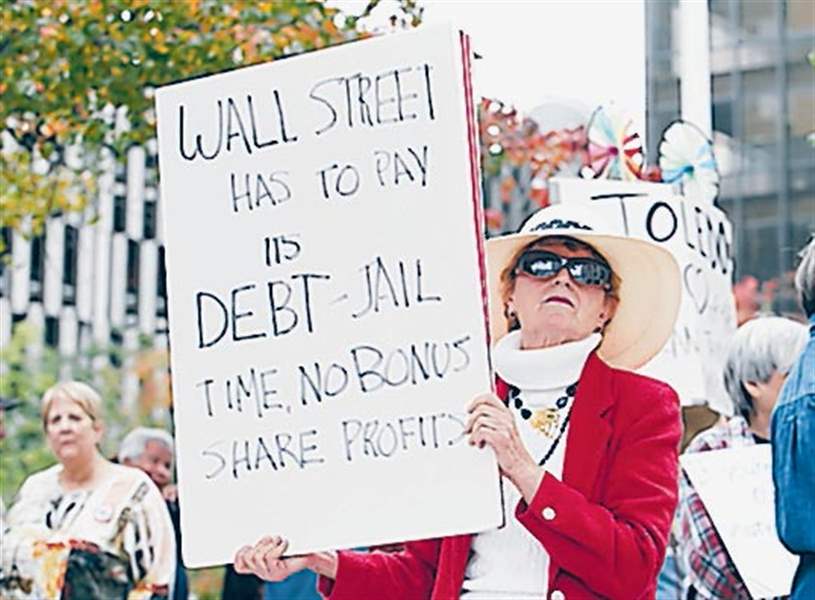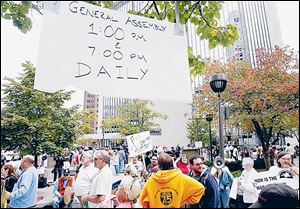
Wall St. protesters fill downtown square
100, many with placards, turn out
10/11/2011
Sandra Frank of Toledo holds a sign demanding Wall Street repay its debts. The Occupy Toledo event, the local version of theanti-Wall Street movement that has sparked imitators nationwide, attracted about 100 people.
THE BLADE/AMY E. VOIGT
Buy This Image

A ‘General Assembly’ sign hangs above rally participants to announce the times for people to come together in Levis Square in downtown Toledo to show their discontent.
About 100 people showed up on downtown Toledo's Levis Square Monday to kick off Occupy Toledo, the local version of the anti-Wall Street movement that has sparked imitators nationwide.
Many protesters hoisted hand-made signs expressing outrage about banks and corporations getting bailed out by the government.
Alex Read, 33, of Toledo, who said he is a federal government employee and member of the "International Socialist Organization," held a banner that read, "Gay Black Straight White Same Struggle Same Fight."
"What brings us out is capitalism and the absolutely crushing weight it places on people," said Mr. Read. He said the banks have received "a blank check" while the people face loss of benefits. "The banks are too big to fail but the 99 percent of us aren't," said Mr. Read, who declined to say which government agency employs him.
Sheena Kadi, 29, of Maumee, said she was protesting the high cost of higher education. She's working on a master's degree in business administration in hopes that it will help her get a job. She has obtained an associate's degree and two bachelor's degrees in business fields. Now she has $95,000 in student loans that she believes she won't ever be able to repay.
"This could be the great defining social movement of our generation," Ms. Kadi said. She said most of the protesters share as a grievance "the corruption of Wall Street and the damage they've done to this economy. Those individuals need to be held accountable."
Among the protesters were some libertarians, who said the government should be reduced in size and the Federal Reserve Bank should be abolished.
Matthew Doty Wood, 26, of Perrysburg, said the banks have too much power and "the federal government has become too big to control."
However, he appeared to be in the minority, with most of the protesters appearing to share the view that the government should provide more benefits and protections for citizens and that corporations and the rich should pay more in taxes and provide more jobs in the United States.

Sandra Frank of Toledo holds a sign demanding Wall Street repay its debts. The Occupy Toledo event, the local version of theanti-Wall Street movement that has sparked imitators nationwide, attracted about 100 people.
A city fire truck drove by on St. Clair Street with lights on and horns blaring. One firefighter gave the protesters a thumbs-up, and the protesters cheered the fire truck.
Several local politicians were on hand for the start of the gathering.
Former Mayor Carty Finkbeiner said the group who launched the movement several weeks ago in New York are heroes for drawing attention to what he said was a financial system that continues to award itself bonuses while refusing to lend money.
"I know there's a lot of voices. It adds up to a clear message -- we can be a great country once again if we recognize you're about as strong as your middle class," he said.
State Rep. Teresa Fedor (D., Toledo) said she was there to hear what people had to say to their government. "The taxpayers bailed out the banks. Where is the accountability of the investing back in the community and creating jobs?" she asked.
City Councilman Steve Steel said Occupy Toledo was an effort to show solidarity with people who believe it's wrong to cut public employees compensation while refusing to require the wealthy to "give something out of their capital gains."
"There's something wrong when the financial system is hurting the many at the expense of the few," Mr. Steel said.
Others protested nuclear power and some chanted in opposition to Issue 2, the referendum on the Nov. 8 ballot to reduce collective bargaining rights of public employees.
By late afternoon, the crowd had dwindled, but appeared to be determined to stay put indefinitely.
Toledo police officers patrolled and two officers with what appeared to be rifle cases were observing the gathering from the roof of an adjacent parking garage.
Levis Square, which was newly re-landscaped by the city several years ago, often hosts live entertainment for lunchtime crowds in the summer, and is a place for downtown office workers taking breaks during the work day.
A new city sign went up in front of the park saying the park, at Madison Avenue and St. Clair Street, is closed from dusk to dawn, anticipating the possibility that protesters would want to camp out. Someone had plastered the sign with a flyer saying "Join the Revolution."
Many of those who showed up were young people, but all ages were represented.
The group met as a "general assembly" at 1 p.m., at which time they agreed on their rules of getting along. They assigned jobs, such as facilitators, note takers, and "vibe watchers" -- to monitor other people's body language and nonverbal communications to make sure that everyone was respected and no one was harassed.
Two men, "facilitators," took turns presiding over the selection of the rest of the officials and agreed on how the assembly would decide things. It was decided that a mere majority of 51 percent would be inadequate, so they agreed that consensus on any act or policy would require approval by at least 90 percent of the assembly -- with a thumbs up or down.
One of the facilitators, Keith Sadler, 55, of the Old West End, said he and several others held a couple of planning meetings.
Mr. Sadler said members, including himself, planned to spend the night on the sidewalks if police would not allow them to stay in the park.
He did not rule out taking more aggressive action, such as doing a "sit-in" or blocking entrance to a bank.
"There's no way to avoid some inconveniencing but we feel the message we're trying to send is one that has to disrupt business as usual," Mr. Sadler said.
Grace, 23, of South Toledo, who would not give her last name, said the slogan "We Are the 99 Percent," which appeared on many signs and was used as a chant, creates an "inclusive environment.
"It points out that we are not the ones getting bailed out. We are the ones that are acting as the ATMs for Wall Street," said Grace, who has a degree in social work but hasn't been able to get a job.
Contact Tom Troy at tomtroy@theblade.com or 419-724-6058.